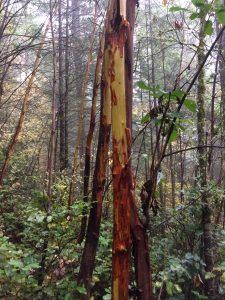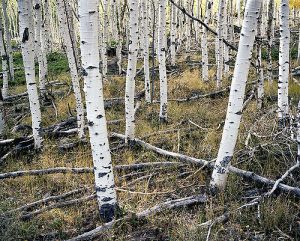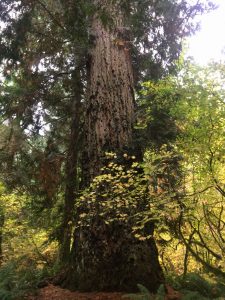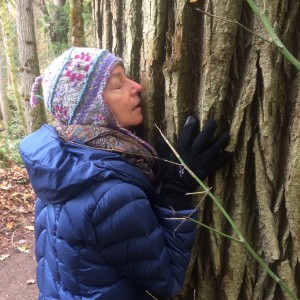 This month our Moving into Meditation class is studying the Yoga Ethic of Brahmacharya. Here are some of the resources we used in this morning’s practice of guided relaxation, mindful movement and sitting meditation.
This month our Moving into Meditation class is studying the Yoga Ethic of Brahmacharya. Here are some of the resources we used in this morning’s practice of guided relaxation, mindful movement and sitting meditation.
The inspiration for our guided relaxation and practice comes from The Hidden Life of Trees: What They Feel, How They Communicate by Peter Wohlleben. You can find a lovely synopsis of the book written by cultural essayist Maria Popova at her BrainPickings.org website.
We crushed the flat sprays of scale-like leaves of Thuja Plicata, our native Western red cedar, between our palms to release its aromatic oils. We breathed them in during our Pranayama practice. Cedarwood brings people together to experience strength and value of community. It inspires the feeling of belonging and assists the heart in opening to receive love and support.
Guided Relaxation
Relax . . . feel your body . . . feel your breathing . . . not having to change it in any way . . . just being breathing . . . feeling the endless cycles of breath that move through our lungs . . . each cycle a gift . . . a gift we freely offer to trees with our outflowing carbon dioxide . . . A gift trees freely give to us . . . Scientists have estimated that between 7 or 8 fully mature sycamore trees to create the 9.5 tons of oxygen a human being breathes in a year. . . Let us, now, feel how we relate through the breath and are related through the breath . . .
 Right now you can imagine yourself in one of your favorite forest places . . . perhaps a forest that you have a physical relationship with . . . or a beautiful forest sanctuary you create in your heart and mind . . . Let yourself feel it’s outer scaly bark and the smoother layers inside . . . not so unlike our own skin and sheathes of fascia inside . . . Gazing at its branching arms . . . bisecting into smaller and smaller patterns mirroring our own arms and legs . . . our own branching arteries . . . veins and nerves . . . Observing the many life forms for whom the tree offers home and sustenance . . . insects, birds, mammals, air plants, fungi, lichen and bacteria.
Right now you can imagine yourself in one of your favorite forest places . . . perhaps a forest that you have a physical relationship with . . . or a beautiful forest sanctuary you create in your heart and mind . . . Let yourself feel it’s outer scaly bark and the smoother layers inside . . . not so unlike our own skin and sheathes of fascia inside . . . Gazing at its branching arms . . . bisecting into smaller and smaller patterns mirroring our own arms and legs . . . our own branching arteries . . . veins and nerves . . . Observing the many life forms for whom the tree offers home and sustenance . . . insects, birds, mammals, air plants, fungi, lichen and bacteria.
 Or we can imagine the 80,000 year old grove of quick aspen standing at Fish Lake Utah – white trunks reflecting, leaves shimmering in the sun. Neighboring trees, scientists found, help each other through their root systems — either directly, by intertwining their roots, or indirectly, by growing fungal networks around the roots that serve as a sort of extended nervous system connecting separate trees.
Or we can imagine the 80,000 year old grove of quick aspen standing at Fish Lake Utah – white trunks reflecting, leaves shimmering in the sun. Neighboring trees, scientists found, help each other through their root systems — either directly, by intertwining their roots, or indirectly, by growing fungal networks around the roots that serve as a sort of extended nervous system connecting separate trees.
The forest and human body and imagination are seamless. As if in meditation, trees carry a serenity that is timeless. Trees protect the quiet & breathe along with us. . .
Like guardians watching over us . . . trees stand long . . . the Great Basin bristlecone pine over 5,000 years . . . Their living forms a wondrous testimony to the practice of brahmacharya . . . brahma-carya pratiṣṭhāyāṁ vīrya-lābhaḥ . . . growing toward the light in balance and moderation . .. their life force . . . boundless . . .
Now arboreal scientists are learning how trees speak a sophisticated silent language, communicating with smell, taste, and electrical impulses. We’re learning
“the role forests play in making our world the kind of place where we want to live.” It’s taken us so long and we’re only just beginning to understand nonhuman consciousnesses. In The Hidden Life of Trees, Peter Wohlleben observes how we are waking up and, in this act of seeing, we begin to care more deeply about these remarkable beings that make our life on this planet possible at all.
Now more than ever our practice and our very survival calls us to learn and embody the wisdom of trees.
Wohlleben ponders this astonishing sociality of trees, abounding with wisdom about what makes strong human communities and societies:
 Why are trees such social beings? Why do they share food with their own species and sometimes even go so far as to nourish their competitors? The reasons are the same as for human communities: there are advantages to working together. A tree is not a forest. On its own, a tree cannot establish a consistent local climate. It is at the mercy of wind and weather. But together, many trees create an ecosystem that moderates extremes of heat and cold, stores a great deal of water, and generates a great deal of humidity. And in this protected environment, trees can live to be very old. To get to this point, the community must remain intact no matter what. If every tree were looking out only for itself, then quite a few of them would never reach old age. Regular fatalities would result in many large gaps in the tree canopy, which would make it easier for storms to get inside the forest and uproot more trees. The heat of summer would reach the forest floor and dry it out. Every tree would suffer.
Why are trees such social beings? Why do they share food with their own species and sometimes even go so far as to nourish their competitors? The reasons are the same as for human communities: there are advantages to working together. A tree is not a forest. On its own, a tree cannot establish a consistent local climate. It is at the mercy of wind and weather. But together, many trees create an ecosystem that moderates extremes of heat and cold, stores a great deal of water, and generates a great deal of humidity. And in this protected environment, trees can live to be very old. To get to this point, the community must remain intact no matter what. If every tree were looking out only for itself, then quite a few of them would never reach old age. Regular fatalities would result in many large gaps in the tree canopy, which would make it easier for storms to get inside the forest and uproot more trees. The heat of summer would reach the forest floor and dry it out. Every tree would suffer.
Every tree, therefore, is valuable to the community and worth keeping around for as long as possible. And that is why even sick individuals are supported and nourished until they recover. Next time, perhaps it will be the other way round, and the supporting tree might be the one in need of assistance.
Even in death the trees falling into a river can change the acidity of the water and stimulate the growth of plankton — the elemental and most significant building block of the entire food chain, on which our own sustenance depends.
A tree can be only as strong as the forest that surrounds it. We can only be as strong as the community around us.
Our human situation is always being nature, nature unfolding – from conception (seed), to birth (sprout), to infancy (seedling), to juvenile (sapling), to adult (mature), to elderly (decline), and finally to death (snag/rotting log).
Our unfolding task . . . of being human cannot be accomplished in isolation. . . .
The point of our practice is that we are reaching out . . . through our roots and branches . . . allowing ourselves to be touched and touching. . . opening to intimacy with life . . .
. . . If our minds are always distracted & unable to settle in one place, it’s impossible to have direct connection with what needs our attention. . . .
 We need genuine contact with our natural world. . . . We need to be present with each other and cultivate a mode of being that is living, wild and direct. . . . Can we slow down? Like long standing trees, can we come to realize the bigger picture of shared sustenance in our human communities – considering the needs of our lifetime and those of future generations?
We need genuine contact with our natural world. . . . We need to be present with each other and cultivate a mode of being that is living, wild and direct. . . . Can we slow down? Like long standing trees, can we come to realize the bigger picture of shared sustenance in our human communities – considering the needs of our lifetime and those of future generations?
Can we learn and embody the wisdom of trees?
